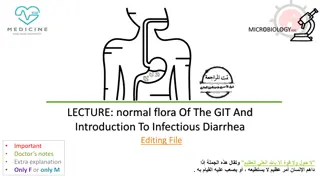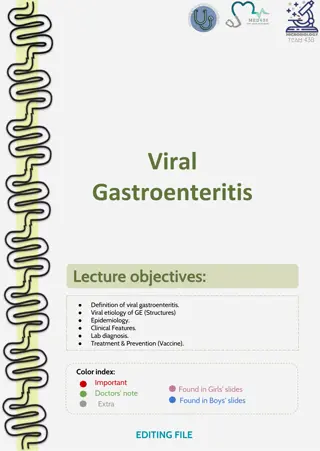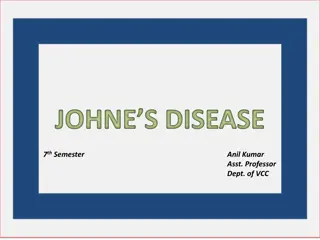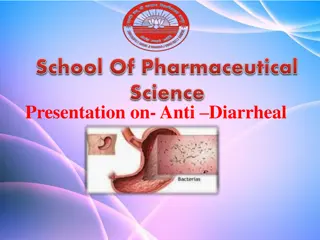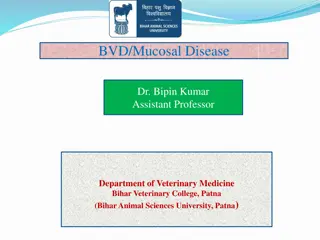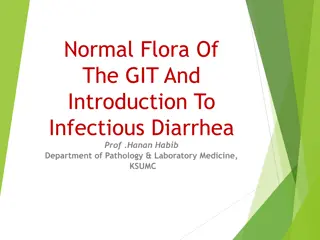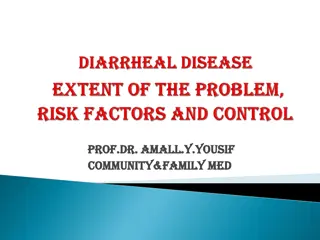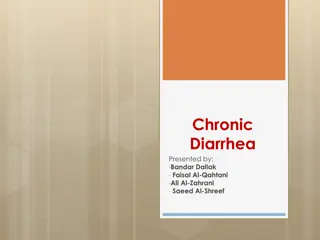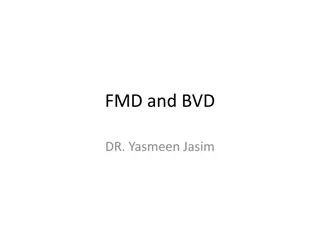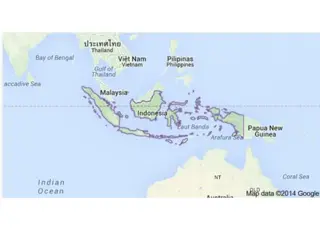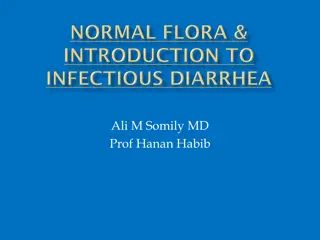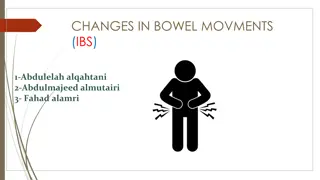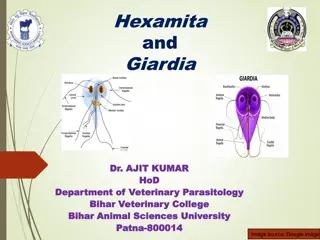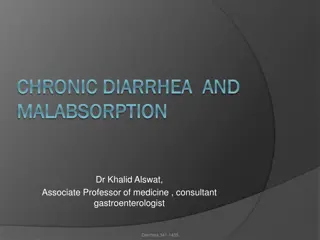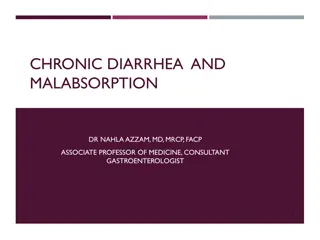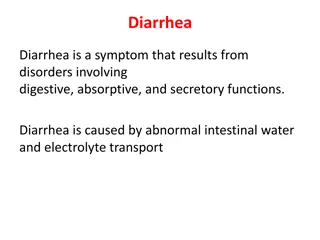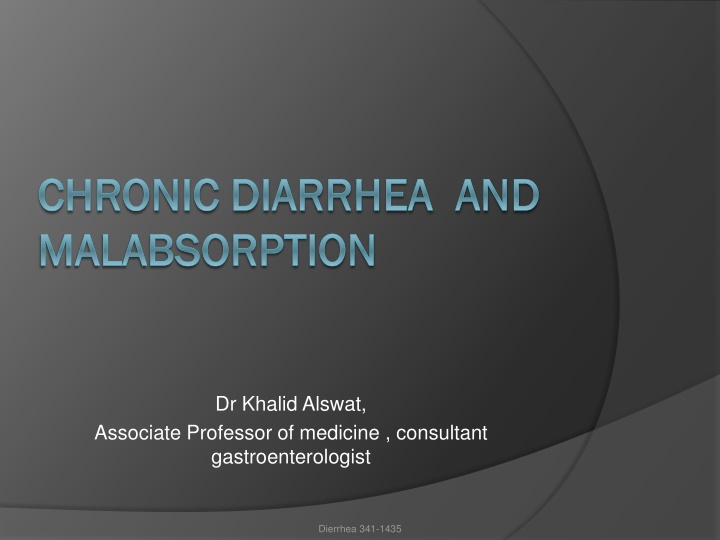
Chronic Diarrhea, Malabsorption, and Gut Functions
Chronic diarrhea and malabsorption are common conditions that can be caused by various factors such as infections, toxins, and underlying health issues. This comprehensive guide explores the pathophysiology, classification, and mechanisms of chronic diarrhea, shedding light on the importance of understanding gut functions for effective management.
Download Presentation

Please find below an Image/Link to download the presentation.
The content on the website is provided AS IS for your information and personal use only. It may not be sold, licensed, or shared on other websites without obtaining consent from the author. If you encounter any issues during the download, it is possible that the publisher has removed the file from their server.
You are allowed to download the files provided on this website for personal or commercial use, subject to the condition that they are used lawfully. All files are the property of their respective owners.
The content on the website is provided AS IS for your information and personal use only. It may not be sold, licensed, or shared on other websites without obtaining consent from the author.
E N D
Presentation Transcript
CHRONIC DIARRHEA AND CHRONIC DIARRHEA AND MALABSORPTION MALABSORPTION Dr Khalid Alswat, Associate Professor of medicine , consultant gastroenterologist Dierrhea 341-1435
Diarrhea Diarrhea is a common and usually transient symptom Chronic diarrhea (liquid stools lasting more than four weeks) may occur in up to 5% of the population in any given year. (weight of stool and frequency are not reliable) Diarrhea is a symptom, not a disease and may occur in many different conditions Dierrhea 341-1435
The gut absorbs most of the fluid that it secretes, and its motility provides a favorable milieu for water, electrolyte, and nutrient absorption When infectious agents, toxins, or other noxious substances are present within the gut fluid secretion and motility are stimulated to expel the unwanted material, thereby producing diarrhea Normal Abnormal Dierrhea 341-1435
This protective response is valuable acutely but, when chronic, is inappropriate and no longer serves an adaptive purpose Epithelial and motor functions are altered in a coordinated fashion to produce diarrhea Dierrhea 341-1435
Fluid loads along the gastrointestinal tract Dierrhea 341-1435
PINES regulatory system in the intestine Dierrhea 341-1435
Classification By time course (acute vs. chronic) volume (large vs. small) Pathophysiology (secretory vs. osmotic) Stool characteristics (watery vs. fatty vs. inflammatory). Epidemiology (epidemic vs. travel-related vs. immunosuppression-related) no single scheme is perfect; the experienced physician uses all of these classifications to expedite patient care Dierrhea 341-1435
Mechanism Secretory diarrhea Exogenous secretagogues Causes Examples Enterotoxins (e.g., cholera) Endogenous secretagogues Neuroendocrine tumors (e.g., carcinoid syndrome) Congenital chloridorrhea Absence of ion transporter Loss of surface area Intestinal resection, diffuse mucosal disease Chronic mesenteric ischemia Intestinal ischemia Rapid intestinal transit Intestinal hurry following vagotomy Magnesium ingestion Osmotic diarrhea Ingestion of a poorly absorbed agent Loss of a nutrient transporter Lactase deficiency Dierrhea 341-1435
SECRETORY DIARRHEA Laxative abuse (nonosmotic laxatives) Post-cholecystectomy (from bile salts) Congenital syndromes (chloridorrhea) Bacterial toxins Ileal bile acid malabsorption Inflammatory bowel disease Ulcerative colitis Crohn's disease Microscopic (lymphocytic) colitis Collagenous colitis Vasculitis Drugs and poisons Disordered motility Postvagotomy diarrhea Postsympathectomy diarrhea Diabetic autonomic neuropathy Hyperthyroidism Irritable bowel syndrome Neuroendocrine tumors Gastrinoma VIPoma Somatostatinoma Mastocytosis Carcinoid syndrome Medullary carcinoma of thyroid Neoplasia Colon carcinoma Lymphoma Dierrhea 341-1435
OSMOTIC DIARRHEA Dierrhea 341-1435
INFLAMMATORY DIARRHEA Inflammatory bowel disease Ulcerative colitis Crohn's disease Infectious diseases Pseudomembranous colitis Tuberculosis, yersinosis Amebiasis/other invasive parasites Ischemic colitis Radiation colitis Neoplasia Colon cancer Lymphoma Dierrhea 341-1435
FATTY DIARRHEA Fatty diarrhea Malabsorption syndromes Mucosal diseases Short bowel syndrome Postresection diarrhea Small bowel bacterial overgrowth Mesenteric ischemia Maldigestion Pancreatic exocrine insufficiency Inadequate luminal bile acid Dierrhea 341-1435
Most of acute diarrhea is due to infectious cause while chronic is due to noninfectious cause Dierrhea 341-1435
Common causes of diarrhea Irritable bowel syndrome (IBS) Inflammatory bowel disease (IBD) Malabsorption syndromes (such as lactose intolerance and celiac disease) Chronic infections (particularly in patients who are immunocompromised) Chronic bacterial Mycobacterial Parasitic infections Then Functional disorders, Malabsorption Inflammatory bowel disease Developing countries Developed countries Dierrhea 341-1435
Approach to patient with diarrhea History Physical examination Laboratory tests Radiology Endoscopy Dierrhea 341-1435
History What led the patient to complain of diarrhea? (eg, consistency or frequency of stools, the presence of urgency or fecal soiling) Stool characteristics: (eg, greasy stools that float and are malodorous may suggest fat malabsorption while the presence of visible blood may suggest inflammatory bowel disease) The volume of the diarrhea: (eg, voluminous watery diarrhea is more likely to be due to a disorder in the small bowel while small-volume frequent diarrhea is more likely to be due to disorders of the colon) Duration of symptoms, nature of onset (sudden or gradual) Weight loss, appetite Occurrence of diarrhea during fasting or at night (suggesting a secretary diarrhea Dierrhea 341-1435
History Systems review:The presence of systemic symptoms:(such as fevers, joint pains, mouth ulcers, eye redness) IBD, CTD, thyroid Association of symptoms with specific food ingestion (such as dairy products or potential food allergens) A history of recurrent bacterial infections (eg, sinusitis, pneumonia), which may indicate a primary immunoglobulin deficiency. Epidemiological factors, such as travel before the onset of illness Family history: IBD Drug Hx: including over the counter mediation Dierrhea 341-1435
Likely cause of diarrhea in certain epidemiologic classifications Travelers: bacterial, protozoal, tropical sprue Diabetics patients AIDS patients infections,drugs Hospitalized patients :drugs, infections, ischemia , C.D toxin Dierrhea 341-1435
Physical examination Physical examination Rarely provides a specific diagnosis. Findings suggestive of IBD (eg, mouth ulcers, a skin rash, episcleritis, an anal fissure or fistula, the presence of visible or occult blood on digital examination, abdominal masses or abdominal pain) Evidence of malabsorption (wasting, physical signs of anemia, scars indicating prior abdominal surgery) Lymphadenopathy (possibly suggesting HIV infection Palpation of the thyroid and examination for exophthalmos and lid retraction may provide support for a diagnosis of hyperthyroidism Dierrhea 341-1435
Investigations(essential in all) CBC ESR Electrolytes Total protein and albumin TFT Stool occult blood Dierrhea 341-1435
Specific investigations The history and physical examination may point toward a specific diagnosis for which testing may be indicated Dierrhea 341-1435
Cases: Case 1: 30 y man with rt iliac fossa pain, diarrhea/ 5 months, wt loss Case 2: 26 y female with female with bloody diarrhea/ 8 weeks Case 3: 22 F with anemia only Dierrhea 341-1435
MALABSORPTION MALABSORPTION Dierrhea 341-1435
Phases of absorption Luminal phase: dietary fats, proteins, and carbohydrates are hydrolyzed and solubilized by secreted digestive enzymes and bile. Mucosal phase: relies on the integrity of the brush-border membrane of intestinal epithelial cells to transport digested products from the lumen into the cells. Postabsorptive phase: nutrients are transported via lymphatics and portal circulation from epithelial cells to other parts of the body. Dierrhea 341-1435
Causes of Causes of malabsorption malabsorption Luminal phase Impaired nutrient hydrolysis The most common cause is pancreatic insufficiency due to chronic pancreatitis, pancreatic resection, pancreatic cancer, or cystic fibrosis. Inactivation of pancreatic enzymes by gastric hypersecretion, as seen in Zollinger-Ellison syndrome . . Dierrhea 341-1435
Impaired micelle formation Impaired micelle formation causes lead to fat malabsorption. This impairment is due to different reasons, including (1) decreased bile salt synthesis from severe parenchymal liver disease (eg, cirrhosis); (2) impaired bile secretion from biliary obstruction or cholestatic jaundice (eg, primary biliary cirrhosis, primary sclerosing cholangitis); (3) impaired enterohepatic bile circulation, as seen in small bowel resection or regional enteritis; (4) bile salt deconjugation due to small bowel bacterial overgrowth . Luminal availability and processing Luminal bacterial overgrowth can cause a decrease in the availability of substrates, including carbohydrates, proteins, and vitamins Dierrhea 341-1435
Mucosal phase Impaired brush-border hydrolase activity Disaccharidase deficiency . Lactase deficiency Immunoglobulin A (IgA) deficiency Dierrhea 341-1435
Impaired nutrient absorption Acquired disorders are far more common and are caused by (1) decreased absorptive surface area, as seen in intestinal resection (2) damaged absorbing surface, as seen in celiac sprue, tropical sprue, giardiasis, Crohn disease, AIDS enteropathy, chemotherapy, or radiation therapy; (3) infiltrating disease of the intestinal wall, such as lymphoma and amyloidosis Dierrhea 341-1435
Postabsorptive phase: Obstruction of the lymphatic system, both congenital (eg, intestinal lymphangiectasia) Acquired (eg, Whipple diseases , lymphoma, tuberculosis), Dierrhea 341-1435
Clinical presentation History : Diarrhea Wt Loss Steatorrhea , Flatulence and abdominal distention ,Edema, anemia, Metabolic defects of bones Dierrhea 341-1435
Physical General Patients may have orthostatic hypotension . Signs of weight loss, muscle wasting, or both may be present . Patients may have signs of loss of subcutaneous fat Cheilosis, glossitis, or aphthous ulcers of the mouth. Abdominal examination The abdomen may be distended, and bowel sounds may be hyperactive . Ascites may be present in severe hypoproteinemia Dierrhea 341-1435
Dermatological manifestations Pale skin Neurological examination Motor weakness, peripheral neuropathy, or ataxia may be present . The Chvostek sign or the Trousseau sign may be evident due to hypocalcemia . Dierrhea 341-1435
Lab Studies Lab Studies Hematological tests A CBC Serum iron, vitamin B-12, and folate Prothrombin time. Electrolytes and chemistries hypokalemia, hypocalcemia, hypomagnesemia, and metabolic acidosis . Protein malabsorption may cause hypoproteinemia and hypoalbuminemia . Fat malabsorption can lead to low serum levels of triglycerides, cholesterol ESR which is elevated in Crohn disease and Whipple disease Dierrhea 341-1435
Stool analysis Stool pH may be assessed. Values of <5.6 are consistent with carbohydrate malabsorption Stool C/S Pus cell in the stool e.g IBD Dierrhea 341-1435
Tests of fat malabsorption For a quantitative measurement of fat absorption, a 72-hour fecal fat collection Qualitative test Sudan III stain of stool,less reliable . Dierrhea 341-1435
Stool --------- fat --------pancreatic, celiac inflammatory ------------ IBD ,infection Dierrhea 341-1435
Schilling test Malabsorption of vitamin B-12 may occur as a consequence of deficiency of intrinsic factor (eg, pernicious anemia, gastric resection), pancreatic insufficiency, bacterial overgrowth, ileal resection, or disease . Dierrhea 341-1435
3 STEPS SCHILLING TEST 1. Oral VIT B12 2. VIT B12 orally +intrinsic factor 3. VIT B12 orally +intrinsic factor+ oral antibiotics Dierrhea 341-1435
Bacterial overgrowth Bacterial overgrowth cause an early rise in breath hydrogen JEUJENAL CULTURE 14c D xylose breath test ,high sensitivity and specificity Dierrhea 341-1435
Serology No serologic tests are specific for malabsorption . Serum Anti-TTG and antiendomysial antibodies can be used to help diagnose celiac sprue . Serum IgA to rule out IgA deficiency Determination of fecal elastase and chymotrypsin (2 proteases produced by the pancreas) can be used to try to distinguish between pancreatic causes and intestinal causes of malabsorption. Dierrhea 341-1435
Imaging Studies Imaging Studies Plain abdominal x-ray film: Pancreatic calcifications are indicative of chronic pancreatitis. Dierrhea 341-1435
Small bowel barium studies . CT scan of the abdomen: (ERCP): pancreatitis Dierrhea 341-1435
Endoscopy Upper endoscopy with small bowel mucosal biopsy . Examples Celiac sprue, Giardiasis Crohn disease, Whipple disease Amyloidosis Lymphoma. Dierrhea 341-1435
Treatment of causative diseases A gluten-free diet helps treat celiac disease . Similarly, a lactose-free diet Protease and lipase supplements are the therapy for pancreatic insufficiency . Antibiotics are the therapy for bacterial overgrowth . Corticosteroids, anti-inflammatory agents, such as mesalamine, and other therapies are used to treat CD Dierrhea 341-1435
Nutritional support Supplementing various minerals calcium, magnesium, iron, and vitamins Caloric and protein replacement also is essential . Medium-chain triglycerides can be used for lymphatic obstruction . In severe intestinal disease, such as massive resection and extensive regional enteritis, parenteral nutrition may become necessary Dierrhea 341-1435

